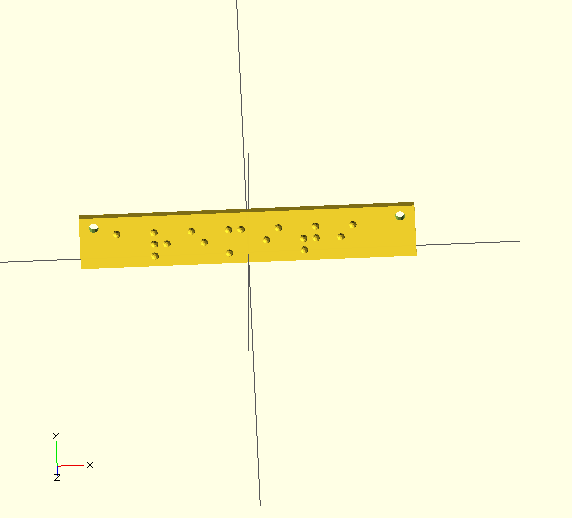Printing Braille labels via OpenSCAD
Saturday night saw me flashing my latest 3D print at a party - is this a new breed of party bore? However my heart-shaped box was admired and got people thing about the possibilities of 3D printing. One friend thought of two project for the visually-impaired: Braille labels and raised contour maps.
There is a surface() function in openscad which reads a text file containing a matrix of z values so that could be useful if I can find a way to generate this data from, say, a portion of a googleMap.
Braille labels looked straightforward. I had a look around and found a number of projects on thingiverse. The one I liked was this Braille label project by polymaker (Brad Pitcher) This prints muliple lines of Grade 1 Braille on a base.
I know nothing about Braile printing but found these guidelines according to which
- height of dot is 0.48 mm
- base of dot is 1.44 mm
- dot spacing 2.34 mm
- character spacing 6.2 mm
polymaker's code uses a hemisphere but I'd like to get closer to the spec. The base of the dot is longer than 2 * height so its really the chord(?)' of a larger sphere. To compute the offset I wrote a function to compute the radius from the height and the chord length:
function chord_radius(length,height) = ( length * length /(4 * height) + height)/2; font_dotHeight = 0.48; font_dotBase = 1.44; font_dotSphereRadius = chord_radius(font_dotBase,font_dotHeight); font_dotSphereOffset = font_dotSphereRadius - font_dotHeight;
I've taken to using global variables for the font variables because I think it's less clear if they are passed around as model parameters. It would be great if openscad had objects but it doesn't.
I also wanted to compute the width of the label which depends on the length of the longest line. There is a max() function in openscad but it only accepts two scalars. Fortunately I found that whilst module calls can't be recursive, function calls can be, so I was able to write a couple of functions, a recursive function and its front-door to find the maximum length:
function max_length_r(v, i, max) =
i == len(v)
? max
: max_length_r(v,
i+1,
len(v[i]) > max
? len(v[i])
: max
)
;
function max_length(v) = max_length_r(v,0,0);
echo (max_length(["cat","dog","master"]));
returns 6.
My openscad code differs in a few other ways to polymaker's but the basis and the braille character data are all his.
Sadly when the STL from this code was printed on a Makerbot, the result was a mess. The dots are too small and joined by threads so that some rethinking about dimensions is needed.
[later: revised code to bring the font to bring it closer to signage dimensions and add holes so a non-braille reader doesnt fix it up-side-down - printing stilll to be tested]
Here is a sample - "Aremiti" , the name of our yacht. This is now uploaded to Thingiverse
My thoughts turned to using the Raspberry Pi to drive a Braille output device, perhaps as simple as a matrix of 6 solenoids to dynamically configure the dot matrix. Looking around I was amazed to discover Bristol Braille, a group with the aim of producing an affordable Braille output device, based in the Bristol Hackspace. Quite a coincidence.
